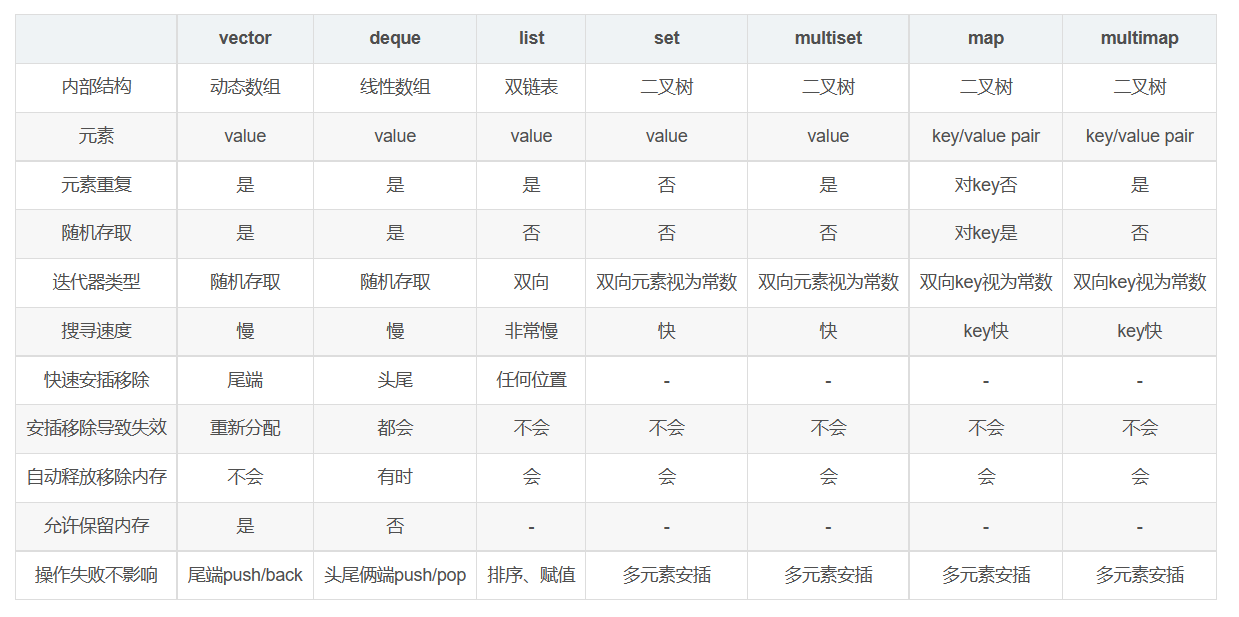前言
长久以来,软件界一直希望建立一种可重复利用的东西,以及一种得以制造出”可重复运用的东西”的方法,从函数(functions),类别(classes),函数库(function libraries),类别库(class libraries)、各种组件,从模块化设计,到面向对象(object oriented ),为的就是复用性的提升。
复用性必须建立在某种标准之上。但是在许多环境下,就连软件开发最基本的数据结构(data structures) 和算法(algorithm)都未能有一套标准。大量程序员被迫从事大量重复的工作,竟然是为了完成前人已经完成而自己手上并未拥有的程序代码,这不仅是人力资源的浪费,也是挫折与痛苦的来源。
为了建立数据结构和算法的一套标准,并且降低他们之间的耦合关系,以提升各自的独立性、弹性、交互操作性(相互合作性,interoperability),诞生了STL。
STL(Standard Template Library,标准模板库),是惠普实验室开发的一系列软件的统称。现在主要出现在 c++中,但是在引入 c++之前该技术已经存在很长时间了。
STL 从广义上分为: 容器(container) 算法(algorithm) 迭代器(iterator)。
容器和算法之间通过迭代器进行无缝连接。STL 几乎所有的代码都采用了模板类或者模板函数,这相比传统的由函数和类组成的库来说提供了更好的代码重用机会。
STL(Standard Template Library)标准模板库,在我们 c++标准程序库中隶属于 STL 的占到了 80%以上。
本文基于B站黑马程序员学习,视频地址
STL六大组件
- STL大体分为六大组件,分别是:容器、算法、迭代器、仿函数、适配器(配接器)、空间配置器
- 容器:各种数据结构,如vector、list、deque、set、map等,用来存放数据。
- 算法:各种常用的算法,如sort、find、copy、for_each等
- 迭代器:扮演了容器与算法之间的胶合剂。
- 仿函数:行为类似函数,可作为算法的某种策略。
- 适配器:一种用来修饰容器或者仿函数或迭代器接口的东西。 6. 空间配置器:负责空间的配置与管理
- 空间配置器:负责空间的配置与管理。
其中最主要的三个是容器、算法还有迭代器
- 容器:置物之所也 STL容器就是将运用最广泛的一些数据结构实现出来 常用的数据结构:数组, 链表,树, 栈, 队列, 集合, 映射表 等 这些容器分为序列式容器和关联式容器两种:
序列式容器:强调值的排序,序列式容器中的每个元素均有固定的位置。
关联式容器:二叉树结构,各元素之间没有 严格的物理上的顺序关系
2.算法:问题之解法也 有限的步骤,解决逻辑或数学上的问题,这一门学科我们叫做算法(Algorithms) 算法分为:质变算法和非质变算 法。
质变算法:是指运算过程中会更改区间内的元素的内容。例如拷贝,替换,删除等等
非质变算法:是指运算过程中不会更改区间内的元素内容,例如查找、计数、遍历、寻找极值等等
3.迭代器:容器和算法之间粘合剂 提供一种方法,使之能够依序寻访某个容器所含的各个元素,而又无需暴露该容器的内部表示方式。 每个容器都有自己专属的迭代器 迭代器使用非常类似于指针。
| 迭代器 | 功能 | 描述 |
|---|---|---|
| 输入迭代器 | 提供对数据的只读访问 | 只读,支持++、==、!= |
| 输出迭代器 | 提供对数据的只写访问 | 只写,支持++ |
| 前向迭代器 | 提供读写操作,并能向前推进迭代器 | 只读,支持++、==、!= |
| 双向迭代器 | 提供读写操作,并能向前和向后操作 | 读写,支持++、– |
| 随机访问迭代器 | 提供读写操作,并能以跳跃的方式访问容器的任意数据,是功能最强的迭代器 | 读写,支持++、–、+n、-n、<、<=、>、>= |
常用的容器中迭代器种类为双向迭代器,和随机访问迭代器
常用容器
以vector容器为例写一个简单的程序
#include <iostream>
#include <vector>
#include <string>
using namespace std;
class My{
public:
My(string a,int b){
this->name=a;
this->age=b;
}
string name;
int age;
};
void test01(){
//存放自定义数据类型
vector<My> t;
My p1("aaa",10);
My p2("bbb",20);
My p3("ccc",30);
My p4("ddd",40);
My p5("eee",50);
//向容器中添加数据
t.push_back(p1);
t.push_back(p2);
t.push_back(p3);
t.push_back(p4);
t.push_back(p5);
//遍历数据
for(vector<My>::iterator it=t.begin();it!=t.end();it++){
cout<<"name "<<(*it).name<<"age "<<(*it).age<<endl;
}
}
int main(){
test01();
return 0;
}
通过代码运行我们可以简单的理解为vector容器就是一个存放数组类型的容器。
string容器
构造函数
- string(); //创建一个空的字符串 例如: string str;
- string(const char* s); //使用字符串s初始化
- string(const string& str); //使用一个string对象初始化另一个string对象 拷贝构造函数
- string(int n, char c); //使用n个字符c初始化
示例:
//构造函数
#include <iostream>
#include <string>
using namespace std;
void test(){
//默认构造
string str1;
//字符串初始化
const char* str = "hello world";
string str2(str);
cout <<"str2="<<str2<<endl;
//拷贝构造函数
string str3(str2);
cout<<"str3="<<str3<<endl;
//n个字符初始化
string str4(10,'a');
cout<<"str4="<<str4<<endl;
}
int main(){
test();
return 0;
}
字符串赋值
- string& operator=(const char* s); //char*类型字符串 赋值给当前的字符串
- string& operator=(const string &s); //把字符串s赋给当前的字符串
- string& operator=(char c); //字符赋值给当前的字符串
- string& assign(const char *s); //把字符串s赋给当前的字符串
- string& assign(const char *s, int n); //把字符串s的前n个字符赋给当前的字符串
- string& assign(const string &s); //把字符串s赋给当前字符串
- string& assign(int n, char c); //用n个字符c赋给当前字符
示例
//字符串赋值
#include <iostream>
#include <string>
using namespace std;
void test(){
//char*类型字符串 赋值给当前的字符串
string str1;
str1="hello world";
cout <<"str1="<<str1<<endl;
//把字符串s赋给当前的字符串
string str2=str1;
cout <<"str2="<<str2<<endl;
//字符赋值给当前的字符串
string str3;
str3='a';
cout <<"str3="<<str3<<endl;
//把字符串s赋给当前的字符串
string str4;
str4.assign("hello STL");
cout <<"str4="<<str4<<endl;
//把字符串s的前n个字符赋给当前的字符串
string str5;
str5.assign(str1,5);
cout <<"str5="<<str5<<endl;
//把字符串s赋给当前字符串
string str6;
str6.assign(str1);
cout <<"str6="<<str6<<endl;
//用n个字符c赋给当前字符
string str7;
str7.assign(10,'w');
cout <<"str7="<<str7<<endl;
}
int main(){
test();
return 0;
}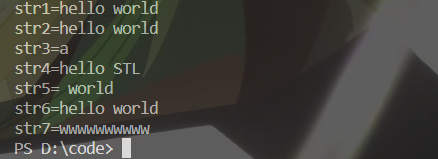
字符串拼接
- string& operator+=(const char* str); //重载+=操作符
- string& operator+=(const char c); //重载+=操作符
- string& operator+=(const string& str); //重载+=操作符
- string& append(const char *s); //把字符串s连接到当前字符串结尾
- string& append(const char *s, int n); //把字符串s的前n个字符连接到当前字符串结尾
- string& append(const string &s); //同operator+=(const string& str)
- string& append(const string &s, int pos, int n); //字符串s中从pos开始的n个字符连接到字符串结尾
示例
//字符串拼接
#include <iostream>
#include <string>
using namespace std;
void test(){
//重载+=操作符 1
string str1;
str1 = "I ";
str1+="Love game";
cout <<"str1="<<str1<<endl;
//重载+=操作符 2
str1+='.';
cout <<"str1="<<str1<<endl;
//重载+=操作符 3
string str2;
str2 = " No,you don't";
str1+=str2;
cout <<"str1="<<str1<<endl;
//把字符串s连接到当前字符串结尾
str1.append(" ....");
cout <<"str1="<<str1<<endl;
//把字符串s的前n个字符连接到当前字符串结尾
str1.append(" bey sdfsdfasdhf",4);
cout <<"str1="<<str1<<endl;
//同operator+=(const string& str)
string str3;
str3 = " aaaa";
str1.append(str3);
cout <<"str1="<<str1<<endl;
//字符串s中从pos开始的n个字符连接到字符串结尾 */
str1.append(str3,0,3);
cout <<"str1="<<str1<<endl;
}
int main(){
test();
return 0;
}
字符串查找替换
- int find(const string& str, int pos = 0) const; //查找str第一次出现位置,从pos开始查找
- int find(const char* s, int pos = 0) const; //查找s第一次出现位置,从pos开始查找
- int find(const char* s, int pos, int n) const; //从pos位置查找s的前n个字符第一次位置
- int find(const char c, int pos = 0) const; //查找字符c第一次出现位置
- int rfind(const string& str, int pos = npos) const; //查找str最后一次位置,从pos开始查找
- int rfind(const char* s, int pos = npos) const; //查找s最后一次出现位置,从pos开始查找
- int rfind(const char* s, int pos, int n) const; //从pos查找s的前n个字符最后一次位置
- int rfind(const char c, int pos = 0) const; //查找字符c最后一次出现位置
- string& replace(int pos, int n, const string& str); //替换从pos开始n个字符为字符串str
- string& replace(int pos, int n,const char* s); //替换从pos开始的n个字符为字符串s
示例
#include <iostream>
#include <string>
using namespace std;
//查找
void test01(){
//使用find
string str = "abcdefg_de";
if(str.find("de")==-1){
cout <<"find erro"<<endl;
}else{
cout <<"find success,this point is "<<str.find("de")<<endl;
}
if(str.find("dg")==-1){
cout <<"find erro"<<endl;
}else{
cout <<"find success,this point is "<<str.find("de")<<endl;
}
//使用rfind
if(str.rfind("de")==-1){
cout <<"rfind erro"<<endl;
}else{
cout <<"rfind success,this point is "<<str.rfind("de")<<endl;
}
if(str.rfind("dg")==-1){
cout <<"rfind erro"<<endl;
}else{
cout <<"rfind success,this point is "<<str.rfind("de")<<endl;
}
//find是从左向右找,rfind是从右往左找
}
//替换
void test02(){
string str = "abcdefg";
str.replace(1,3,"1111");//把一号位置后面三个位置替换为1111
cout <<"str="<<str<<endl;
}
int main(){
test01();
test02();
return 0;
}
字符串比较和存取
- int compare(const string &s) const; //与字符串s比较
- int compare(const char *s) const; //与字符串s比较
- char& operator[] (int n); //通过[]方式取字符
- char& at(int n); //通过at方法获取字符
示例
#include <iostream>
#include <string>
using namespace std;
//字符串比较
void test01(){
string str1 ="hello";
string str2 ="hello";
if(str1.compare(str2)==0){
cout <<"str1 == str2"<<endl;
}else{
cout <<"str1!=str2"<<endl;
}
}
//字符串存取
void test02(){
//通过[]方式取字符
string str ="hello";
for(int i =0; i<str.size();i++){
cout <<str[i]<<" ";
}
cout << endl;
//通过at方法获取字符
for(int i =0; i<str.size();i++){
cout <<str.at(i)<<" ";
}
cout << endl;
//修改字符串中的字符
str[0]='x';
str.at(1)='m';
cout <<"str="<<str<<endl;
}
int main(){
test01();
cout <<"-------------"<<endl;
test02();
return 0;
}
字符串插入与删除
- string& insert(int pos, const char* s); //插入字符串
- string& insert(int pos, const string& str); //插入字符串
- string& insert(int pos, int n, char c); //在指定位置插入n个字符c
- string& erase(int pos, int n = npos); //删除从Pos开始的n个字符
示例
#include <iostream>
#include <string>
using namespace std;
//插入字符串
void test01(){
string str1 = "hello ";
string str2 = "world";
str1.insert(6,str2);
cout <<"str1="<<str1<<endl;
//在指定位置插入n个字符c
str1.insert(11,1,' ');
str1.insert(12,3,'m');
cout <<"str1="<<str1<<endl;
}
//删除字符串
void test02(){
string str = "asdjfhldskjhf";
str.erase(3,5);
cout <<"str="<<str<<endl;
}
int main(){
test01();
test02();
return 0;
}
字符串子串
- string substr(int pos = 0, int n = npos) const; //返回由pos开始的n个字符组成的字符串
示例
#include<string>
#include<iostream>
using namespace std;
//截取用户名
void test(){
string emil = "zhangfsdf@qq.com";
int pos=emil.find("@");
string emilUser = emil.substr(0,pos);
cout <<"emilUser is "<<emilUser<<endl;
}
int main(){
test();
return 0;
}
vector容器
vector数据结构和数组非常相似,也称为单端数组,不同之处在于数组是静态空间,而vector可以动态扩展
动态扩展并不是在原空间之后续接新空间,而是找更大的内存空间,然后将原数据拷贝新空间,释放原空间
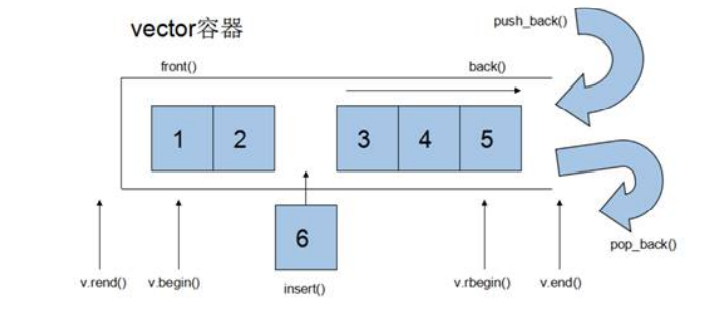
构造函数
- vector v; //采用模板实现类实现,默认构造函数
- vector(v.begin(), v.end()); //将v[begin(), end())区间中的元素拷贝给本身
- vector(n, elem); //构造函数将n个elem拷贝给本身
- vector(const vector &vec); //拷贝构造函数
示例
#include <iostream>
#include <vector>
using namespace std;
void printVector(vector<int>& t){
for(vector<int>::iterator it=t.begin();it!=t.end();it++){
cout <<(*it)<<" ";
}
cout << endl;
}
void test(){
//采用模板实现类实现,默认构造函数
vector<int>a;
for(int i=0;i<10;i++){
a.push_back(i);
}
printVector(a);
//将v[begin(), end())区间中的元素拷贝给本身
vector<int>b(a.begin(),a.end());
printVector(b);
//构造函数将n个elem拷贝给本身
vector<int>c(10,100);
printVector(c);
//拷贝构造函数
vector<int>d(c);
printVector(d);
}
int main(){
test();
return 0;
}
vector赋值
- vector& operator=(const vector &vec); //重载等号操作符
- assign(beg, end); //将[beg, end)区间中的数据拷贝赋值给本身
- assign(n, elem); //将n个elem拷贝赋值给本身
示例
#include <iostream>
#include <vector>
using namespace std;
void printVector(vector<int>& t){
for(vector<int>::iterator it=t.begin();it!=t.end();it++){
cout <<(*it)<<" ";
}
cout << endl;
}
void test(){
vector<int>a;
for(int i=0;i<10;i++){
a.push_back(i);
}
printVector(a);
//重载等号操作符
vector<int>b;
b=a;
printVector(b);
//将[beg, end)区间中的数据拷贝赋值给本身
vector<int>c;
c.assign(b.begin(),b.end());
printVector(c);
//将n个elem拷贝赋值给本身
vector<int>d;
d.assign(10,100);
printVector(d);
}
int main(){
test();
return 0;
}
vector容量和大小
- empty(); //判断容器是否为空
- capacity(); //容器的容量
- size(); //返回容器中元素的个数
- resize(int num); //重新指定容器的长度为num,若容器变长,则以默认值填充新位置。 //如果容器变短,则末尾超出容器长度的元素被删除
- resize(int num, elem); //重新指定容器的长度为num,若容器变长,则以elem值填充新位置。 //如果容器变短,则末尾超出容器长度的元素被删除
示例
#include<iostream>
#include<vector>
using namespace std;
void printVector(vector<int>& t){
for(vector<int>::iterator it=t.begin();it!=t.end();it++){
cout<<(*it)<<" ";
}
cout << endl;
}
void test(){
vector<int>a;
for(int i = 0;i<10;i++){
a.push_back(i);
}
printVector(a);
//如果是空的
if(a.empty()){
cout<<"a is empty"<<endl;
}else{
cout<<"a is not empty "<<endl;
cout<<"a capacity is "<<a.capacity()<<endl;
cout<<"a size is "<<a.size()<<endl;
}
a.resize(15,1);//重设size大小,多余的空间用1填充
printVector(a);
a.resize(5);//设置的比原来小,把后面多的删除了
printVector(a);
}
int main(){
test();
return 0;
}
vector插入和删除
- push_back(ele); //尾部插入元素ele
- pop_back(); //删除最后一个元素
- insert(const_iterator pos, ele); //迭代器指向位置pos插入元素ele
- insert(const_iterator pos, int count,ele); //迭代器指向位置pos插入count个元素ele
- erase(const_iterator pos); //删除迭代器指向的元素
- erase(const_iterator start, const_iterator end); //删除迭代器从start到end之间的元素
- clear(); //删除容器中所有元素
#include<iostream>
#include<vector>
using namespace std;
void printVector(vector<int>& t){
for(vector<int>::iterator it=t.begin();it!=t.end();it++){
cout <<*it<<" ";
}
cout << endl;
}
void test(){
vector<int>a;
//尾部插入元素ele
a.push_back(10);
a.push_back(20);
a.push_back(30);
a.push_back(40);
a.push_back(50);
//遍历
printVector(a);
//删除最后一个元素
a.pop_back();
printVector(a);
//迭代器指向位置pos插入元素ele
a.insert(a.begin()+2,3); //在第二个位置插入一个3
printVector(a);
//迭代器指向位置pos插入count个元素ele
a.insert(a.begin(),3,100);//在开始位置插入三个100
printVector(a);
//删除迭代器指向的元素
a.erase(a.begin());
printVector(a);
//删除迭代器从start到end之间的元素
a.erase(a.begin(),a.begin()+2);
printVector(a);
//删除容器中所有元素
a.clear();
if(a.empty()){
cout<<"a is empty"<<endl;
}else{
cout<<"a is not empty "<<endl;
cout<<"a capacity is "<<a.capacity()<<endl;
cout<<"a size is "<<a.size()<<endl;
}
}
int main(){
test();
return 0;
}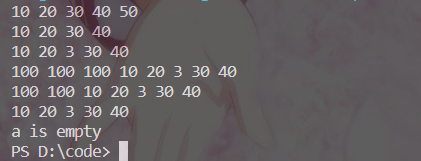
vector数据存取
- at(int idx); //返回索引idx所指的数据
- operator[]; //返回索引idx所指的数据
- front(); //返回容器中第一个数据元素
- back(); //返回容器中最后一个数据元素
示例
#include <iostream>
#include <vector>
using namespace std;
void test(){
vector<int>v;
for(int i;i<v.size();i++){
v.push_back(i);
}
//返回索引idx所指的数据
for(int i = 0; i<10;i++){
cout <<v.at(i)<< " ";
}
cout << endl;
//返回索引idx所指的数据
for(int i = 0; i<10;i++){
cout <<v[i]<< " ";
}
cout << endl;
//返回容器中第一个数据元素
cout <<"第一个数据元素 "<<v.front()<<endl;
//返回容器中最后一个数据元素
cout <<"最后一个数据元素 "<<v.back()<<endl;
}
int main(){
test();
return 0;
}vector互换容器
实现两个容器内元素进行互换
- swap(vec); // 将vec与本身的元素互换
示例
#include <iostream>
#include <vector>
using namespace std;
void printVector(vector<int> t)
{
for(vector<int>::iterator it = t.begin();it!=t.end();it++){
cout << *it <<" ";
}
cout << endl;
}
void test(){
vector<int>a;
vector<int>b;
for(int i = 0;i<10;i++){
a.push_back(i);
}
for(int i = 10;i>0;i--){
b.push_back(i);
}
cout <<"交换前"<<endl;
printVector(a);
printVector(b);
cout <<"交换后"<<endl;
a.swap(b);
printVector(a);
printVector(b);
}
int main(){
test();
return 0;
}
vector预留空间
- reserve(int len); //容器预留len个元素长度,预留位置不初始化,元素不可访问
示例
#include <iostream>
#include <vector>
using namespace std;
//不预留空间,看看空间开辟次数
void test01(){
vector<int>a;
int num=0;
int *p = NULL;
for(int i = 0;i<100000;i++){
a.push_back(i);
if(p!=&a[0]){
p=&a[0];
num++;//因为每次重新开辟,头地址都会换位置,可以这么统计开辟次数
}
}
cout <<"开辟次数:"<<num<<endl;
}
//预留空间
void test02(){
vector<int>a;
a.reserve(100000);
int num=0;
int *p = NULL;
for(int i = 0;i<100000;i++){
a.push_back(i);
if(p!=&a[0]){
p=&a[0];
num++;
}
}
cout <<"开辟次数:"<<num<<endl;
}
int main(){
test01();
test02();
return 0;
}
deque容器
双端数组,可以对头端进行插入删除操作
deque与vector的区别
- vector对于头部的插入删除效率低,数据量越大,效率越低 deque相对而言,
- 对头部的插入删除速度回比vector快
- vector访问元素时的速度会比deque快,这和两者内部实现有关
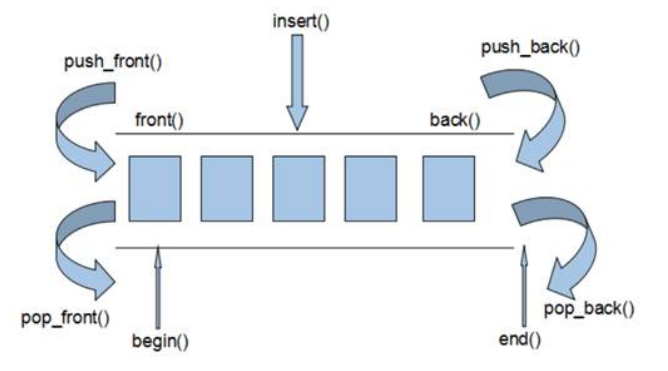
deque内部有个中控器,维护每段缓冲区中的内容,缓冲区中存放真实数据 中控器维护的是每个缓冲区的地址,使得使用deque时像一片连续的内存空间

deque构造函数
- deque deqT; //默认构造形式
- deque(beg, end); //构造函数将[beg, end)区间中的元素拷贝给本身
- deque(n, elem); //构造函数将n个elem拷贝给本身
- deque(const deque &deq); //拷贝构造函数
示例
#include <iostream>
#include <deque>
using namespace std;
void printDeque(const deque<int>& t){
for(deque<int>::const_iterator it = t.begin(); it!=t.end();it++){
cout <<*it<<" ";
}
cout << endl;
}
void test(){
//默认构造形式
deque<int>a;
for(int i = 0; i < 10; i++){
a.push_back(i);
}
printDeque(a);
//构造函数将[beg, end)区间中的元素拷贝给本身
deque<int>b(a.begin()+5,a.end());
printDeque(b);
//构造函数将n个elem拷贝给本身
deque<int>c(10,100);
printDeque(c);
//拷贝构造函数
deque<int>d(c);
printDeque(d);
}
int main(){
test();
return 0;
}
与vector的构造基本一致
deque赋值操作
- deque& operator=(const deque &deq); //重载等号操作符
- assign(beg, end); //将[beg, end)区间中的数据拷贝赋值给本身
- assign(n, elem); //将n个elem拷贝赋值给本身
示例
#include <iostream>
#include <deque>
using namespace std;
void printDeque(const deque<int>& t){
for(deque<int>::const_iterator it = t.begin(); it!=t.end();it++){
cout <<*it<<" ";
}
cout << endl;
}
void test(){
deque<int>a;
for(int i = 0; i < 10; i++){
a.push_back(i);
}
printDeque(a);
//重载等号操作符
deque<int>b;
b=a;
printDeque(b);
//将[beg, end)区间中的数据拷贝赋值给本身
deque<int>c;
c.assign(b.begin()+5,b.end()-2);
printDeque(c);
//将n个elem拷贝赋值给本身
deque<int>d;
d.assign(10,100);
printDeque(d);
}
int main(){
test();
return 0;
}

与vector基本相同
deque大小操作
- deque.empty(); //判断容器是否为空
- deque.size(); //返回容器中元素的个数
- deque.resize(num); //重新指定容器的长度为num,若容器变长,则以默认值填充新位置。 //如果容器变短,则末尾超出容器长度的元素被删除
- deque.resize(num, elem); //重新指定容器的长度为num,若容器变长,则以elem值填充新位置。 //如果容器变短,则末尾超出容器长度的元素被删除
示例
#include <iostream>
#include <deque>
using namespace std;
void printDeque(const deque<int>& t){
for(deque<int>::const_iterator it = t.begin(); it!=t.end();it++){
cout <<*it<<" ";
}
cout << endl;
}
void test(){
//判断容器是否为空
deque<int>a;
deque<int>b;
for(int i = 0; i < 10; i++){
a.push_back(i);
}
if(a.empty()){
cout <<"这个容器是空的"<<endl;
}else{
cout <<"这个容器不是空的且";
//返回容器中元素的个数
cout << "这个容器的size为: "<<a.size()<<endl;
}
if(b.empty()){
cout <<"这个容器是空的"<<endl;
}else{
cout <<"这个容器不是空的"<<endl;
//返回容器中元素的个数
cout << "这个容器的size为: "<<a.size()<<endl;
}
//重新指定容器的长度为num,若容器变长,则以默认值填充新位置。 //如果容器变短,则末尾超出容器长度的元素被删除
a.resize(15);
printDeque(a);
a.resize(5);
printDeque(a);
}
int main(){
test();
return 0;
}
deque没有容量的概念
deque 插入和删除
两端插入操作:
- push_back(elem); //在容器尾部添加一个数据
- push_front(elem); //在容器头部插入一个数据
- pop_back(); //删除容器最后一个数据
- pop_front(); //删除容器第一个数据
指定位置操作:
- insert(pos,elem); //在pos位置插入一个elem元素的拷贝,返回新数据的位置。
- insert(pos,n,elem); //在pos位置插入n个elem数据,无返回值。
- insert(pos,beg,end); //在pos位置插入[beg,end)区间的数据,无返回值。
- clear(); //清空容器的所有数据
- erase(beg,end); //删除[beg,end)区间的数据,返回下一个数据的位置。
- erase(pos); //删除pos位置的数据,返回下一个数据的位置。
示例
#include <iostream>
#include <deque>
using namespace std;
void printDeque(const deque<int>& t){
for(deque<int>::const_iterator it = t.begin(); it!=t.end();it++){
cout <<*it<<" ";
}
cout << endl;
}
void test01(){
//判断容器是否为空
deque<int>a;
deque<int>b;
a.push_back(10);
a.push_back(20);
a.push_back(30);
a.push_back(40);
a.push_back(50);
cout <<"在容器a尾部添加一个数据"<<endl;
printDeque(a);
b.push_front(10);
b.push_front(20);
b.push_front(30);
b.push_front(40);
b.push_front(50);
cout <<"在容器b头部插入一个数据"<<endl;
printDeque(b);
cout <<"删除容器a最后一个数据"<<endl;
a.pop_back();
printDeque(a);
cout <<"删除容器d第一个数据"<<endl;
b.pop_front();
printDeque(b);
}
/* insert(pos,elem); //在pos位置插入一个elem元素的拷贝,返回新数据的位置。
insert(pos,n,elem); //在pos位置插入n个elem数据,无返回值。
insert(pos,beg,end); //在pos位置插入[beg,end)区间的数据,无返回值。
clear(); //清空容器的所有数据
erase(beg,end); //删除[beg,end)区间的数据,返回下一个数据的位置。
erase(pos); //删除pos位置的数据,返回下一个数据的位置。
*/
void test02(){
//判断容器是否为空
deque<int>a;
deque<int>b;
a.push_back(10);
a.push_back(20);
a.push_back(30);
a.push_back(40);
a.push_back(50);
b.push_front(1);
b.push_front(2);
b.push_front(3);
b.push_front(4);
b.push_front(5);
cout <<"在pos位置插入一个elem元素的拷贝"<<endl;
a.insert(a.begin(),100);
printDeque(a);
cout<<"在pos位置插入n个elem数据"<<endl;
a.insert(a.begin(),3,10);
printDeque(a);
cout<<"在pos位置插入[beg,end)区间的数据"<<endl;
a.insert(a.begin(),b.begin(),b.end());
printDeque(a);
cout<<"删除[beg,end)区间的数据"<<endl;
a.erase(a.begin()+1,a.begin()+4);
printDeque(a);
cout <<"删除pos位置的数据"<<endl;
a.erase(a.end());
printDeque(a);
}
int main(){
test01();
test02();
return 0;
}
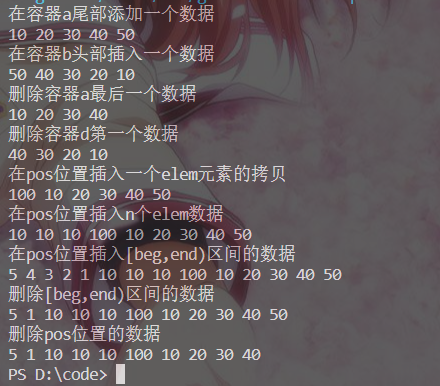
deque 数据存取
- at(int idx); //返回索引idx所指的数据
- operator[]; //返回索引idx所指的数据
- front(); //返回容器中第一个数据元素
- back(); //返回容器中最后一个数据元素
示例
#include <iostream>
#include <deque>
using namespace std;
void printDeque(const deque<int>& t){
for(deque<int>::const_iterator it = t.begin(); it!=t.end();it++){
cout <<*it<<" ";
}
cout << endl;
}
void test(){
//默认构造形式
deque<int>a;
for(int i = 0; i < 10; i++){
a.push_back(i);
}
cout <<"返回索引idx所指的数据 at(5)="<<a.at(5)<<" a[4]="<<a[4]<<endl;
cout <<"返回容器中第一个数据元素 a.front()="<<a.front()<<endl;
cout <<"返回容器中最后一个数据元素 a.back()="<<a.back()<<endl;
printDeque(a);
}
int main(){
test();
return 0;
}
deque 排序
利用算法实现对deque容器进行排序
- sort(iterator beg, iterator end) //对beg和end区间内元素进行排序
示例
#include <iostream>
#include <deque>
#include <algorithm>
using namespace std;
void printDeque(const deque<int>& t){
for(deque<int>::const_iterator it = t.begin(); it!=t.end();it++){
cout <<*it<<" ";
}
cout << endl;
}
void test(){
//默认构造形式
deque<int>a;
a.push_back(12);
a.push_back(43);
a.push_back(21);
a.push_back(1);
a.push_back(90);
a.push_back(3);
printDeque(a);
sort(a.begin(),a.end());
printDeque(a);
}
int main(){
test();
return 0;
}sort算法非常实用,使用时包含头文件 algorithm即可
stack容器
stack是一种先进后出(First In Last Out,FILO)的数据结构,它只有一个出口
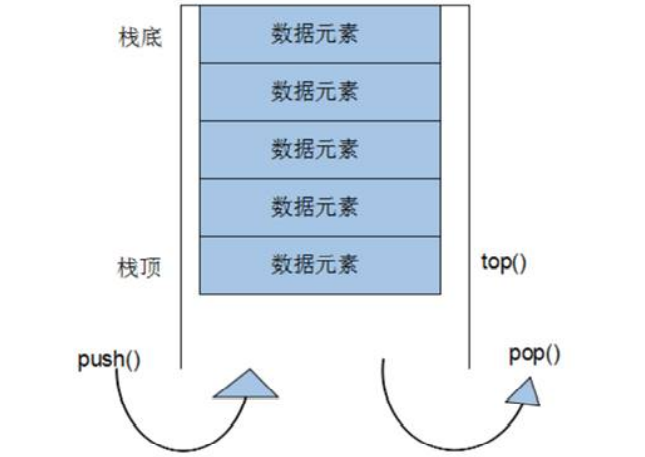
- 栈中只有顶端的元素才可以被外界使用,因此栈不允许有遍历行为
- 栈中进入数据称为 — 入栈 push
- 栈中弹出数据称为 — 出栈 pop
常用接口
构造函数
- stack stk; //stack采用模板类实现, stack对象的默认构造形式
- stack(const stack &stk); //拷贝构造函数
赋值操作:
- stack& operator=(const stack &stk); //重载等号操作符
数据存取:
- push(elem); //向栈顶添加元素
- pop(); //从栈顶移除第一个元素
- top(); //返回栈顶元素
大小操作:
- empty(); //判断堆栈是否为空
- size(); //返回栈的大小
示例
#include<iostream>
#include<stack>
using namespace std;
void test(){
//构造函数创建
stack<int>a;
//数据存取,向栈中添加元素,叫做 压栈 入栈
a.push(10);
a.push(20);
a.push(30);
a.push(40);
a.push(50);
cout <<"这个栈的大小是:"<<a.size()<<endl;
//栈是不能遍历的
while(!a.empty()){
//查看栈顶数据
cout <<"栈顶数据是:"<<a.top()<<endl;
//出栈
a.pop();
}
cout <<"这个栈的大小是:"<<a.size()<<endl;
}
int main(){
test();
return 0;
}
queue容器
Queue是一种先进先出(First In First Out,FIFO)的数据结构,它有两个出口
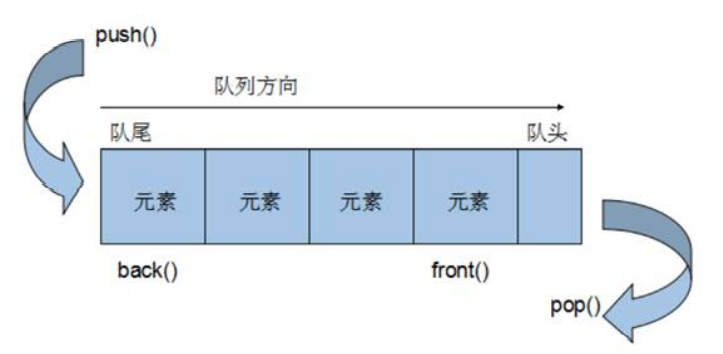
- 队列容器允许从一端新增元素,从另一端移除元素
- 队列中只有队头和队尾才可以被外界使用,因此队列不允许有遍历行为
- 队列中进数据称为 — 入队 push
- 队列中出数据称为 — 出队 pop
常用接口
构造函数:
- queue que; //queue采用模板类实现,queue对象的默认构造形式
- queue(const queue &que); //拷贝构造函数
赋值操作:
- queue& operator=(const queue &que); //重载等号操作符
数据存取:
- push(elem); //往队尾添加元素
- pop(); //从队头移除第一个元素
- back(); //返回最后一个元素
- front(); //返回第一个元素
大小操作:
- empty(); //判断堆栈是否为空
- size(); //返回栈的大小
示例
#include<iostream>
#include<string>
#include<queue>
using namespace std;
class Person{
public:
friend void test();
Person(int age,string name){
this->age=age;
this->name=name;
}
private:
int age;
string name;
};
void test(){
//构造函数
queue<Person>a;
//数据存取
Person p1(19,"张三");
Person p2(20,"李四");
Person p3(25,"王二");
Person p4(18,"刘五");
a.push(p1);
a.push(p2);
a.push(p3);
a.push(p4);
cout <<"这个队列大小是:"<<a.size()<<endl;
while(!a.empty()){
cout<<"排头的名字和年龄分别是"<<a.front().name<<" "<<a.front().age<<endl;
cout<<"排尾的名字和年龄分别是"<<a.back().name<<" "<<a.back().age<<endl;
//出队
a.pop();
}
cout <<"这个队列大小是:"<<a.size()<<endl;
}
int main(){
test();
return 0;
}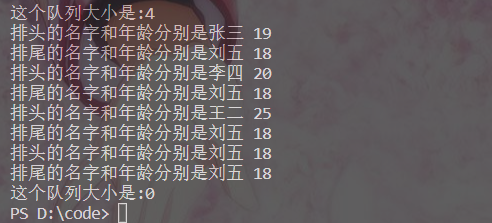
list容器
链表(list)是一种物理存储单元上非连续的存储结构,数据元素的逻辑顺序是通过链表中的指针链接实现的
链表的组成:链表由一系列结点组成
结点的组成:一个是存储数据元素的数据域,另一个是存储下一个结点地址的指针域
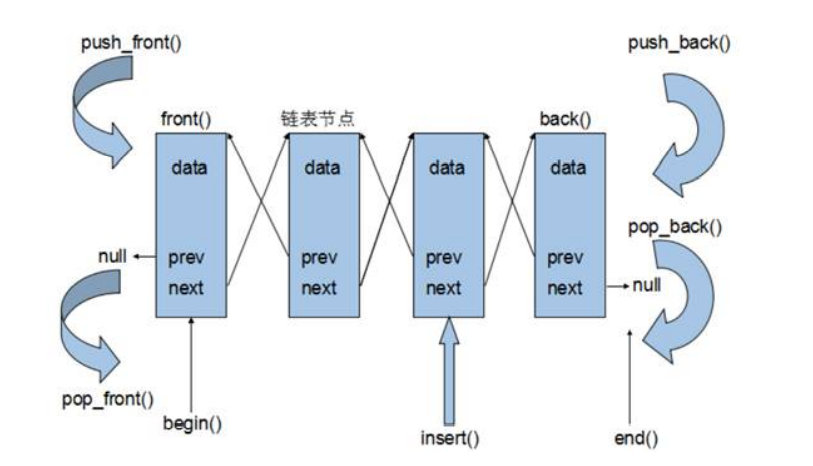
由于链表的存储方式并不是连续的内存空间,因此链表list中的迭代器只支持前移和后移,属于双向迭代器
list的优缺点:
- 采用动态存储分配,不会造成内存浪费和溢出
- 链表执行插入和删除操作十分方便,修改指针即可,不需要移动大量元素
- 链表灵活,但是空间(指针域) 和 时间(遍历)额外耗费较大
list构造函数
- list lst; //list采用采用模板类实现,对象的默认构造形式:
- list(beg,end); //构造函数将[beg, end)区间中的元素拷贝给本身
- list(n,elem); //构造函数将n个elem拷贝给本身
- list(const list &lst); //拷贝构造函数
示例
#include<iostream>
#include<list>
using namespace std;
void printList(const list<int>& t){
for(list<int>::const_iterator it = t.begin();it!=t.end();it++){
cout <<*it<<" ";
}
cout << endl;
}
void test(){
list<int>a;
a.push_back(10);
a.push_back(20);
a.push_back(30);
a.push_back(40);
a.push_back(50);
cout<<"list采用采用模板类实现,对象的默认构造形式:"<<endl;
printList(a);
a.pop_front();
a.pop_back();
cout <<"构造函数将[beg, end)区间中的元素拷贝给本身"<<endl;
list<int>b(a.begin(),a.end());
printList(b);
cout <<"构造函数将n个elem拷贝给本身"<<endl;
list<int>c(5,10);
printList(c);
c.pop_back();
c.pop_front();
cout <<"拷贝构造函数"<<endl;
list<int>d(c);
printList(d);
}
int main(){
test();
return 0;
}
list 赋值和交换
- 给list容器进行赋值,以及交换list容器
- assign(beg, end); //将[beg, end)区间中的数据拷贝赋值给本身
- assign(n, elem); //将n个elem拷贝赋值给本身
- list& operator=(const list &lst); //重载等号操作符
- swap(lst); //将lst与本身的元素互换
示例
#include <iostream>
#include <list>
using namespace std;
void printList(const list<int>& t){
for(list<int>::const_iterator it = t.begin();it!=t.end();it++){
cout <<*it <<" ";
}
cout << endl;
}
void test(){
list<int>a;
for(int i = 0;i<10;i++){
a.push_back(i);
}
cout <<"将[beg, end)区间中的数据拷贝赋值给本身。"<<endl;
list<int>b;
b.assign(a.begin(),a.end());
printList(b);
cout <<"将n个elem拷贝赋值给本身。"<<endl;
list<int>c(10,5);
printList(c);
cout <<"重载等号操作符"<<endl;
a.pop_back();
a.pop_front();
list<int>d;
d=a;
printList(d);
cout <<"将lst与本身的元素互换"<<endl;
d.swap(b);
printList(d);
}
int main()
{
test();
return 0;
}
list 大小操作
- size(); //返回容器中元素的个数
- empty(); //判断容器是否为空
- resize(num); //重新指定容器的长度为num,若容器变长,则以默认值填充新位置。 //如果容器变短,则末尾超出容器长度的元素被删除。
- resize(num, elem); //重新指定容器的长度为num,若容器变长,则以elem值填充新位置。 //如果容器变短,则末尾超出容器长度的元素被删除。
示例
#include <iostream>
#include <list>
using namespace std;
void printList(const list<int>& t){
for(list<int>::const_iterator it = t.begin();it!=t.end();it++){
cout <<*it <<" ";
}
cout << endl;
}
void if_empty(const list<int>& t){
if(t.empty()){
cout <<"这个容器是空的"<<endl;
}else{
cout <<"这个容器不是空的,其中的元素个数为:"<<t.size()<<endl;
}
}
void test(){
list<int>a;
list<int>b;
for(int i = 0;i<10;i++){
a.push_back(i);
}
if_empty(a);
if_empty(b);
cout <<"重新指定容器的长度为num,重载版本"<<endl;
b.resize(10,1);
printList(b);
}
int main()
{
test();
return 0;
}
list 插入和删除
- push_back(elem);//在容器尾部加入一个元素
- pop_back();//删除容器中最后一个元素
- push_front(elem);//在容器开头插入一个元素
- pop_front();//从容器开头移除第一个元素
- insert(pos,elem);//在pos位置插elem元素的拷贝,返回新数据的位置
- insert(pos,n,elem);//在pos位置插入n个elem数据,无返回值
- insert(pos,beg,end);//在pos位置插入[beg,end)区间的数据,无返回值
- clear();//移除容器的所有数据
- erase(beg,end);//删除[beg,end)区间的数据,返回下一个数据的位置
- erase(pos);//删除pos位置的数据,返回下一个数据的位置
- remove(elem);//删除容器中所有与elem值匹配的元素
示例
#include <iostream>
#include <list>
using namespace std;
void printList(const list<int>& t){
for(list<int>::const_iterator it = t.begin();it!=t.end();it++){
cout <<*it <<" ";
}
cout << endl;
}
void test(){
list<int>a;
list<int>b;
a.push_back(10);
a.push_back(20);
a.push_back(30);
a.push_back(40);
a.push_back(50);
cout <<"在a容器尾部加入一个元素 "<<endl;
printList(a);
cout <<"删除a容器中最后一个元素 "<<endl;
a.pop_back();
printList(a);
b.push_front(10);
b.push_front(20);
b.push_front(30);
b.push_front(40);
b.push_front(50);
cout <<"在容器b开头插入一个元素 "<<endl;
printList(b);
cout <<"删除容器b中第一个元素"<<endl;
b.pop_front();
printList(b);
cout <<"在pos位置插elem元素的拷贝"<<endl;
list<int>::iterator it = a.begin();
a.insert(++it,114514);
printList(a);
cout <<"删除容器中所有与elem值匹配的元素"<<endl;
b.remove(30);
printList(b);
cout <<"输入想删除pos位置的数据"<<endl;
int n;
cin>>n;
it=a.begin();
for(int i=0;i<n-1;i++){
it++;
}
a.erase(it);
printList(a);
}
int main()
{
test();
return 0;
}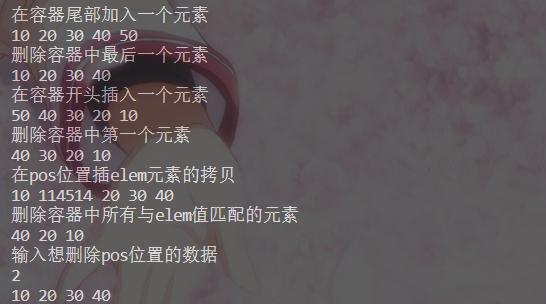
list 数据存取
- front(); //返回第一个元素
- back(); //返回最后一个元素
示例
#include <iostream>
#include <list>
using namespace std;
void test(){
list<int>a;
a.push_back(10);
a.push_back(20);
a.push_back(30);
a.push_back(40);
a.push_back(50);
cout<<"链表a第一个元素是:"<<a.front()<<endl;
cout<<"链表a最后一个元素是:"<<a.back()<<endl;
//cout << L1.at(0) << endl;//错误 不支持at访问数据
//cout << L1[0] << endl; //错误 不支持[]方式访问数据
}
int main()
{
test();
return 0;
} list
it= it+1;这也是错误的写法
因为list容器的迭代器是双向迭代器,不支持随机访问
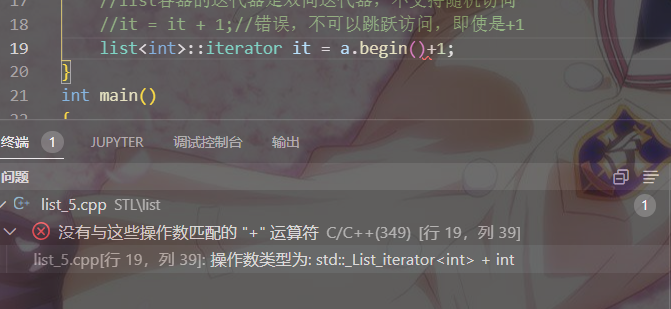
list 反转和排序
- 将容器中的元素反转,以及将容器中的数据进行排序
- reverse(); //反转链表
- sort(); //链表排序 这个sort不再是#include
中的,而是成员函数
#include <iostream>
#include <list>
using namespace std;
void printList(const list<int>& t){
for(list<int>::const_iterator it = t.begin();it!=t.end();it++){
cout <<*it <<" ";
}
cout << endl;
}
void test(){
list<int>a;
list<int>b;
a.push_back(10);
a.push_back(20);
a.push_back(30);
a.push_back(40);
a.push_back(50);
cout<<"反转链表前"<<endl;
printList(a);
cout<<"反转链表后"<<endl;
a.reverse();
printList(a);
b.push_front(23);
b.push_front(43);
b.push_front(34);
b.push_front(9);
b.push_front(12);
cout <<"链表排序前"<<endl;
printList(b);
cout <<"链表排序后"<<endl;
b.sort();
printList(b);
}
int main()
{
test();
return 0;
}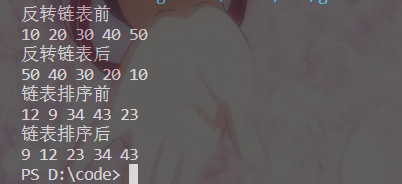
set/ multiset 容器
所有元素都会在插入时自动被排序
set/multiset属于关联式容器,底层结构是用二叉树实现
set不允许容器中有重复的元素 multiset允许容器中有重复的元素
set构造和赋值
- set st; //默认构造函数
- set(const set &st); //拷贝构造函数
- set& operator=(const set &st); //重载等号操作符
示例
#include <iostream>
#include <set>
using namespace std;
void printSet(const set<int>& t){
for(set<int>::const_iterator it = t.begin();it!=t.end();it++){
cout<<*it<<" ";
}
cout << endl;
}
void test(){
set<int>a;
a.insert(20);
a.insert(50);
a.insert(30);
a.insert(10);
a.insert(40);
cout <<"默认构造函数"<<endl;
printSet(a);
cout <<"拷贝构造函数"<<endl;
set<int>b(a);
printSet(b);
cout <<"重载等号操作符"<<endl;
set<int>c;
c=a;
printSet(c);
}
int main(){
test();
return 0;
}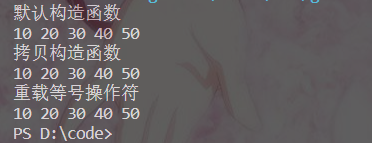
set容器插入数据时用insert
set大小和交换
- size(); //返回容器中元素的数目
- empty(); //判断容器是否为空
- swap(st); //交换两个集合容器
示例
#include <iostream>
#include <set>
using namespace std;
void printSet(const set<int>& t){
for(set<int>::const_iterator it = t.begin();it!=t.end();it++){
cout<<*it<<" ";
}
cout << endl;
}
void if_empty(const set<int>& t){
if(t.empty()){
cout <<"这个容器是空的"<<endl;
}else{
cout<<"这个容器不是空的,并且容器大小为:"<<t.size()<<endl;
}
}
void test(){
set<int>a;
a.insert(20);
a.insert(50);
a.insert(30);
a.insert(10);
a.insert(40);
set<int>b;
b.insert(1);
b.insert(5);
b.insert(2);
b.insert(4);
b.insert(3);
set<int>c;
if_empty(a);
if_empty(c);
cout <<"交换前"<<endl;
printSet(a);
printSet(b);
cout <<"交换后"<<endl;
a.swap(b);
printSet(a);
printSet(b);
}
int main(){
test();
return 0;
}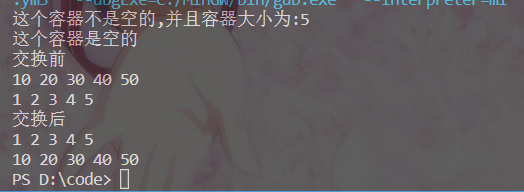
set插入和删除
- insert(elem); //在容器中插入元素
- clear(); //清除所有元素
- erase(pos); //删除pos迭代器所指的元素,返回下一个元素的迭代器
- erase(beg, end); //删除区间[beg,end)的所有元素 ,返回下一个元素的迭代器
- erase(elem); //删除容器中值为elem的元素
示例
#include <set>
#include <iostream>
using namespace std;
void printSet(set<int> &s)
{
for (set<int>::iterator it = s.begin(); it != s.end(); it++)
{
cout << *it << " ";
}
cout << endl;
}
// 插入和删除
void test01()
{
set<int> s1;
// 插入
s1.insert(10);
s1.insert(30);
s1.insert(20);
s1.insert(40);
printSet(s1);
// 删除
s1.erase(s1.begin());
printSet(s1);
s1.erase(30);
printSet(s1);
// 清空
// s1.erase(s1.begin(), s1.end());
s1.clear();
printSet(s1);
}
int main()
{
test01();
system("pause");
return 0;
}
与前面基本一致
set查找和统计
- find(key); //查找key是否存在,若存在,返回该键的元素的迭代器;若不存在,返回set.end();
- count(key); //统计key的元素个数,返回值是0 或者 1
#include <iostream>
#include <set>
using namespace std;
void test(){
set<double>a;
a.insert(1.0);
a.insert(4.0);
a.insert(2.0);
a.insert(3.0);
a.insert(5.0);
set<double>::iterator it = a.find(3.0);
if(it!=a.end()){
cout <<"找到了这个元素"<<endl;
}else{
cout<<"没找到这个元素"<<endl;
}
int m = a.count(1.0);
int n = a.count(223);
cout <<m<<endl;
cout <<n<<endl;
}
int main(){
test();
return 0;
}
set和multiset区别
- set不可以插入重复数据,而multiset可以
- set插入数据的同时会返回插入结果,表示插入是否成功
- multiset不会检测数据,因此可以插入重复数据
示例
#include <iostream>
#include <set>
using namespace std;
void test(){
set<int>a;
//判断是否插入成功
pair<set<int>::iterator,bool> ret = a.insert(10);
if(ret.second){
cout<<"插入成功"<<endl;
}else{
cout<<"插入失败"<<endl;
}
ret = a.insert(10);
if(ret.second){
cout<<"插入成功"<<endl;
}else{
cout<<"插入失败"<<endl;
}
multiset<int>b;
b.insert(10);
b.insert(10);
b.insert(10);
b.insert(10);
for(multiset<int>::iterator it = b.begin();it!=b.end();it++){
cout<<*it<<" ";
}
cout << endl;
}
int main(){
test();
return 0;
}multise用法基本一样,只是multiset允许插入重复的数据
pair对组创建
成对出现的数据,利用对组可以返回两个数据
创建方式:
- pair p ( value1, value2 );
- pair p = make_pair( value1, value2 );
示例
#include <iostream>
#include <string>
using namespace std;
int main(){
pair<string,int>a("张三",18);
pair<string,int> b = make_pair("李四",20);
cout <<"第一个人叫"<<a.first<<"年龄是"<<a.second<<endl;
cout <<"第二个人叫"<<b.first<<"年龄是"<<b.second<<endl;
return 0;
}
set容器排序
set是会默认从小到大排序,利用仿函数,可以改变排序规则
示例
#include <iostream>
#include <set>
#include <string>
using namespace std;
class Person{
public:
string name;
int age;
int hight;
Person(string name,int age,int hight){
this->name=name;
this->age=age;
this->hight=hight;
}
};
class MyCompare
{
public:
bool operator()(const Person& p1,const Person& p2) const{
if(p1.age == p2.age){
return p1.hight < p2.hight;
}else{
return p1.age < p2.age;
}
}
};
void test(){
Person a1("张三",18,170);
Person a2("李四",22,165);
Person a3("王二",22,180);
Person a4("刘五",22,190);
Person a5("陈七",17,176);
set<Person,MyCompare>a;
a.insert(a1);
a.insert(a2);
a.insert(a3);
a.insert(a4);
a.insert(a5);
for (set<Person, MyCompare>::iterator it = a.begin(); it != a.end(); it++){
cout << "姓名: " << it->name << " 年龄: " << it->age << "身高:"<<it->hight<<endl;
}
}
int main(){
test();
return 0;
}
map/ multimap容器
map中所有元素都是pair
pair中第一个元素为key(键值),起到索引作用,
第二个元素为value(实值) 所有元素都会根据元素的键值自动排序
map/multimap属于关联式容器,底层结构是用二叉树实现
可以根据key值快速找到value值
map不允许容器中有重复key值元素
multimap允许容器中有重复key值元素
是不能重复key值而不是value值
map构造和赋值
- map mp; //map默认构造函数
- map(const map &mp); //拷贝构造函数
- map& operator=(const map &mp); //重载等号操作符
示例
#include <iostream>
#include <map>
using namespace std;
void printMap(const map<int,int>& t ){
for(map<int,int>::const_iterator it = t.begin();it!=t.end();it++){
cout <<it->first<<" "<<it->second<<" ";
cout << endl;
}
cout << endl;
}
void test(){
map<int,int>m;
m.insert(pair<int,int>(1,10));
m.insert(pair<int,int>(2,20));
m.insert(pair<int,int>(3,30));
m.insert(pair<int,int>(4,40));
m.insert(pair<int,int>(5,50));
cout <<"默认构造"<<endl;
printMap(m);
map<int,int>n(m);
cout <<"拷贝构造"<<endl;
printMap(n);
map<int,int>s;
s=m;
cout <<"赋值"<<endl;
printMap(s);
}
int main(){
test();
return 0;
}map中所有元素都是成对出现,插入数据时候要使用对组
map大小和交换
- size(); //返回容器中元素的数目
- empty(); //判断容器是否为空
- swap(st); //交换两个集合容器
示例
#include <iostream>
#include <map>
using namespace std;
void printMap(const map<int,int>& t ){
for(map<int,int>::const_iterator it = t.begin();it!=t.end();it++){
cout <<it->first<<" "<<it->second<<"|";
}
cout << endl;
}
void if_empty(const map<int,int>& t ){
if(t.empty()){
cout <<"这个容器是空的"<<endl;
}else{
cout <<"这个容器不是空的,大小为"<<t.size()<<endl;
}
}
void test(){
map<int,int>m;
map<int,int>n;
m.insert(pair<int,int>(1,10));
m.insert(pair<int,int>(2,20));
m.insert(pair<int,int>(3,30));
m.insert(pair<int,int>(4,40));
m.insert(pair<int,int>(5,50));
if_empty(m);
if_empty(n);
map<int,int>s;
s.insert(pair<int,int>(1,22));
s.insert(pair<int,int>(2,32));
cout <<"交换前"<<endl;
printMap(m);
printMap(s);
cout <<"交换后"<<endl;
m.swap(s);
printMap(m);
printMap(s);
}
int main(){
test();
return 0;
}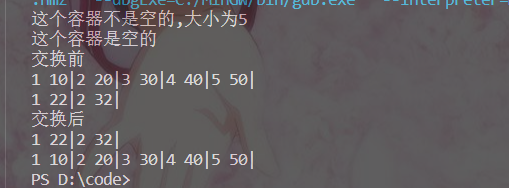
map插入和删除
- insert(elem); //在容器中插入元素。
- clear(); //清除所有元素
- erase(pos); //删除pos迭代器所指的元素,返回下一个元素的迭代器。
- erase(beg, end); //删除区间[beg,end)的所有元素 ,返回下一个元素的迭代器。
- erase(key); //删除容器中值为key的元素。
示例
#include <iostream>
#include <map>
using namespace std;
void printMap(const map<int,int>& t ){
for(map<int,int>::const_iterator it = t.begin();it!=t.end();it++){
cout <<it->first<<" "<<it->second<<"|";
}
cout << endl;
}
void if_empty(const map<int,int>& t ){
if(t.empty()){
cout <<"这个容器是空的"<<endl;
}else{
cout <<"这个容器不是空的,大小为"<<t.size()<<endl;
}
}
void test(){
map<int,int>m;
//插入方式一
m.insert(pair<int,int>(1,10));
//插入方式二
m.insert(make_pair(2,20));
//插入方式三
m.insert(map<int,int>::value_type(3,30));
//插入方式四
m[4]=40;
printMap(m);
map<int,int>::iterator it = m.begin();
m.erase(++it);
cout<<"删除元素"<<endl;
printMap(m);
cout<<"删除key为3的元素"<<endl;
m.erase(3);
printMap(m);
cout<<"清空数据"<<endl;
m.clear();
if_empty(m);
}
int main(){
test();
return 0;
}
map查找和统计
- find(key); //查找key是否存在,若存在,返回该键的元素的迭代器;若不存在,返回set.end();
- count(key); //统计key的元素个数
示例
#include <map>
#include <iostream>
using namespace std;
// 查找和统计
void test01()
{
map<int, int> m;
m.insert(pair<int, int>(1, 10));
m.insert(pair<int, int>(2, 20));
m.insert(pair<int, int>(3, 30));
// 查找
map<int, int>::iterator pos = m.find(3);
if (pos != m.end())
{
cout << "找到了元素 key = " << (*pos).first << " value = " << (*pos).second << endl;
}
else
{
cout << "未找到元素" << endl;
}
// 统计
int num = m.count(3);
cout << "num = " << num << endl;
}
int main()
{
test01();
system("pause");
return 0;
}find的返回值还是迭代器
count的返回值不是0就是1
map容器排序
默认的是从小到大,利用仿函数,可以改变排序规则
示例
#include <map>
#include <iostream>
using namespace std;
class MyCompare
{
public:
bool operator()(int v1, int v2) const
{
return v1 > v2;
}
};
void test01()
{
// 默认从小到大排序
// 利用仿函数实现从大到小排序
map<int, int, MyCompare> m;
m.insert(make_pair(1, 10));
m.insert(make_pair(2, 20));
m.insert(make_pair(3, 30));
m.insert(make_pair(4, 40));
m.insert(make_pair(5, 50));
for (map<int, int, MyCompare>::iterator it = m.begin(); it != m.end(); it++)
{
cout << "key:" << it->first << " value:" << it->second << endl;
}
}
int main()
{
test01();
system("pause");
return 0;
}基本上与其他的容器排序方法相同,同样这里可以排序自定义类型
函数对象
函数对象
- 重载函数调用操作符的类,其对象常称为函数对象
- 函数对象使用重载的()时,行为类似函数调用,也叫仿函数
函数对象(仿函数)是一个类,不是一个函数
函数对象的使用:
- 函数对象在使用时,可以像普通函数那样调用, 可以有参数,可以有返回值
- 函数对象超出普通函数的概念,函数对象可以有自己的状态
- 函数对象可以作为参数传递
示例
#include <iostream>
#include <string>
using namespace std;
class Myadd{
public:
int operator()(int a,int b){
return a + b;
}
};
class Myprint{
public:
Myprint(){
count = 0;
}
void operator()(string a){
cout << a << endl;
count++;
}
int count;
};
void doPrint(Myprint& t,string p){
t(p);
}
void test(){
cout <<"函数对象在使用时,可以像普通函数那样调用, 可以有参数,可以有返回值"<<endl;
Myadd myadd;
cout <<"myadd(10,30)="<<myadd(10,30)<<endl;
cout <<"函数对象超出普通函数的概念,函数对象可以有自己的状态"<<endl;
Myprint myprint;
myprint("hello world");
myprint("hello world");
myprint("hello world");
myprint("hello world");
cout <<"一共打印了"<<myprint.count<<"次"<<endl;
cout <<"函数对象可以作为参数传递"<<endl;
doPrint(myprint,"hello C++");
}
int main(){
test();
return 0;
}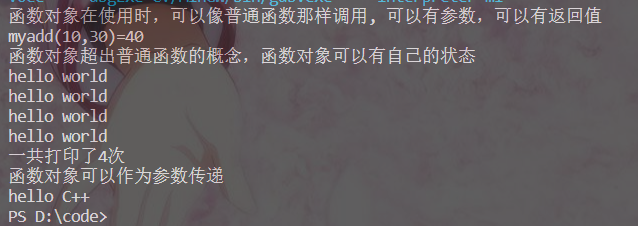
仿函数写法非常灵活,可以作为参数进行传递。
谓词
- 返回bool类型的仿函数称为谓词
- 如果operator()接受一个参数,那么叫做一元谓词
- 如果operator()接受两个参数,那么叫做二元谓词
一元谓词
示例
#include <iostream>
#include <vector>
#include <algorithm>
using namespace std;
class My{
public:
bool operator()(int a){
return a>5;
}
};
void test(){
vector<int>a;
for(int i = 0; i<10; i++){
a.push_back(i);
}
vector<int>::iterator it = find_if(a.begin(),a.end(),My());//My()是匿名函数
//这里使用了find_if算法
if(it == a.end()){
cout <<"没有找到" <<endl;
}else{
cout <<"找到了大于5的数为:"<<*it<<endl;
}
}
int main(){
test();
return 0;
}二元谓词
sort算法默认是从小到大排序,利用仿函数可以改成从大到小排序
#include <vector>
#include <algorithm>
#include <iostream>
using namespace std;
// 二元谓词
class MyCompare
{
public:
bool operator()(int num1, int num2)
{
return num1 > num2;
}
};
void test01()
{
vector<int> v;
v.push_back(10);
v.push_back(40);
v.push_back(20);
v.push_back(30);
v.push_back(50);
// 默认从小到大
sort(v.begin(), v.end());
for (vector<int>::iterator it = v.begin(); it != v.end(); it++)
{
cout << *it << " ";
}
cout << endl;
cout << "----------------------------" << endl;
// 使用函数对象改变算法策略,排序从大到小
sort(v.begin(), v.end(), MyCompare());
for (vector<int>::iterator it = v.begin(); it != v.end(); it++)
{
cout << *it << " ";
}
cout << endl;
}
int main()
{
test01();
return 0;
}内建函数对象
- STL内建了一些函数对象
- 这些仿函数所产生的对象,用法和一般函数完全相同
- 使用内建函数对象,需要引入头文件 #include< functional>
分类:
- 算术仿函数
- 关系仿函数
- 逻辑仿函数
算术函数
- 实现四则运算
- 其中negate是一元运算,其他都是二元运算
- template T plus //加法仿函数
- template T minus //减法仿函数
- template T multiplies //乘法仿函数
- template T divides //除法仿函数
- template T modulus //取模仿函数
- template T negate //取反仿函数
示例
#include <iostream>
#include <functional>
using namespace std;
void test(){
cout <<"negate()"<<endl;
negate<int>a;
cout <<"10取反是"<<a(10)<<endl;
cout <<"plus()"<<endl;
plus<int>b;
cout <<"10+1="<<b(10,1)<<endl;
cout <<"modulus()"<<endl;
modulus<int>c;
cout<<"3模2等于"<<c(3,2)<<endl;
}
int main(){
test();
return 0;
}
关系仿函数
- template bool equal_to //等于
- template bool not_equal_to //不等于
- template bool greater //大于
- template bool greater_equal //大于等于
- template bool less //小于
- template bool less_equal //小于等于
在二元谓词的时候我们自己写了sort从大到小的排序,这里就可以直接使用关系仿函数
示例
#include <iostream>
#include <functional>
#include <vector>
#include <algorithm>
using namespace std;
void test(){
vector<int>a;
a.push_back(21);
a.push_back(12);
a.push_back(31);
a.push_back(2);
a.push_back(11);
cout <<"排序前"<<endl;
for(vector<int>::iterator it =a.begin();it!=a.end();it++){
cout <<*it<<" ";
}
cout << endl;
sort(a.begin(),a.end(),greater<int>());
cout <<"排序后"<<endl;
for(vector<int>::iterator it =a.begin();it!=a.end();it++){
cout <<*it<<" ";
}
cout << endl;
}
int main(){
test();
return 0;
}
逻辑仿函数
- template bool logical_and //逻辑与
- template bool logical_or //逻辑或
- template bool logical_not //逻辑非
示例
#include <vector>
#include <functional>
#include <algorithm>
#include <iostream>
using namespace std;
void test01()
{
vector<bool> v;
v.push_back(true);
v.push_back(false);
v.push_back(true);
v.push_back(false);
for (vector<bool>::iterator it = v.begin(); it != v.end(); it++)
{
cout << *it << " ";
}
cout << endl;
// 逻辑非 将v容器搬运到v2中,并执行逻辑非运算
vector<bool> v2;
v2.resize(v.size());//不开辟空间不能运行
transform(v.begin(), v.end(), v2.begin(), logical_not<bool>());
for (vector<bool>::iterator it = v2.begin(); it != v2.end(); it++)
{
cout << *it << " ";
}
cout << endl;
}
int main()
{
test01();
return 0;
}常用算法
算法主要是由头文件< algorithm>,< functional>,< numeric>组成。
< algorithm>是所有STL头文件中最大的一个,范围涉及到比较、 交换、查找、遍历操作、复制、修改等等
< numeric>体积很小,只包括几个在序列上面进行简单数学运算的模板函数
< functional>定义了一些模板类,用以声明函数对象。
遍历算法
- for_each //遍历容器
- transform //搬运容器到另一个容器中
for_each
函数原型:
- for_each(iterator beg, iterator end, _func);
- 遍历算法 遍历容器元素
- beg 开始迭代器
- end 结束迭代器
- _func 函数或者函数对象
示例
#include <iostream>
#include <vector>
#include <algorithm>
using namespace std;
void print(int a){
cout <<a<<" ";
}
class Myprint{
public:
void operator()(int a){
cout <<a<<" ";
}
};
void test(){
vector<int>a;
a.push_back(10);
a.push_back(20);
a.push_back(30);
a.push_back(40);
a.push_back(50);
cout <<"普通函数"<<endl;
for_each(a.begin(),a.end(),print);
cout << endl;
cout <<"函数对象"<<endl;
for_each(a.begin(),a.end(),Myprint());
}
int main(){
test();
return 0;
}
普通函数是不用加括号的,函数对象要加上括号创建匿名函数
transform
函数原型:
- transform(iterator beg1, iterator end1, iterator beg2, _func)
- beg1 源容器开始迭代器
- end1 源容器结束迭代器
- beg2 目标容器开始迭代器
- _func 函数或者函数对象
示例
#include <vector>
#include <functional>
#include <algorithm>
#include <iostream>
using namespace std;
void print(int a){
cout <<a<<" ";
}
class Tranform{
public:
int operator()(int a){
return a-1;//这里的返回值要是int,相当于先把值传给这个函数运算后再返回给v2
}
};
void test01()
{
vector<int> v;
v.push_back(12);
v.push_back(13);
v.push_back(14);
v.push_back(15);
cout <<"v的数据是"<<endl;
for_each(v.begin(),v.end(),print);
cout << endl;
vector<int> v2;
v2.resize(v.size());//不开辟空间不能运行
cout<<"把v中的元素都-1再传入v2"<<endl;
transform(v.begin(), v.end(), v2.begin(),Tranform());
cout <<"v2的数据是"<<endl;
for_each(v2.begin(),v2.end(),print);
}
int main()
{
test01();
return 0;
}
查找算法
find //查找元素
find_if //按条件查找元素
adjacent_find //查找相邻重复元素
binary_search //二分查找法
count //统计元素个数
count_if //按条件统计元素个数
find
查找指定元素,找到返回指定元素的迭代器,找不到返回结束迭代器end()
函数原型:
- find(iterator beg, iterator end, value);
- 按值查找元素,找到返回指定位置迭代器,找不到返回结束迭代器位置
- beg 开始迭代器
- end 结束迭代器
- value 查找的元素
- 返回值是迭代器
示例:
#include <iostream>
#include <vector>
#include <algorithm>
#include <string>
using namespace std;
//查找自定义数据类型
class Person{
public:
Person(string name,int age,int hight){
this->name = name;
this->age = age;
this->hight = hight;
}
//对于自定义的类型,使用find是重载 == 符号,不然find不知道怎么比较
bool operator==(const Person& p1){
if(this->name == p1.name &&
this->age == p1.age &&
this->hight == p1.hight){
return true;
}else{
return false;
}
}
string name;
int age;
int hight;
};
void test(){
Person a1("张三",18,170);
Person a2("李四",22,165);
Person a3("王二",22,180);
Person a4("刘五",22,190);
Person a5("陈七",17,176);
Person aa("张三",18,170);
vector<Person>v;
v.push_back(a1);
v.push_back(a2);
v.push_back(a3);
v.push_back(a4);
v.push_back(a5);
vector<Person>::iterator it = find(v.begin(),v.end(),aa);
if(it == v.end()){
cout <<"没有找"<<endl;
}else{
cout <<"找到了"<<it->name<<" "<<it->age<<" "<<it->hight<<endl;
}
}
int main(){
test();
return 0;
}在查找定义类型的时候一定要重载==符号
find_if
按条件查找元素
函数原型:
- find_if(iterator beg, iterator end, _Pred);
- 按值查找元素,找到返回指定位置迭代器,找不到返回结束迭代器位置
- beg 开始迭代器
- end 结束迭代器
- _Pred 函数或者谓词(返回bool类型的仿函数)
- 返回值是迭代器
示例
//所有找年龄大于20的人
/* find(iterator beg, iterator end, value); */
#include <iostream>
#include <vector>
#include <algorithm>
#include <string>
using namespace std;
//查找自定义数据类型
class Person{
public:
Person(string name,int age,int hight){
this->name = name;
this->age = age;
this->hight = hight;
}
//使用一元谓词
bool operator()(const Person& p1){
return p1.age > this->age;
}
string name;
int age;
int hight;
};
class My{
public:
//使用一元谓词
bool operator()(const Person& p1){
return p1.age > 20;
}
};
void test(){
Person a1("陈七",17,176);
Person a2("李四",11,165);
Person a3("张三",18,170);
Person a4("王二",11,180);
Person a5("刘五",19,190);
vector<Person>v;
v.push_back(a1);
v.push_back(a2);
v.push_back(a3);
v.push_back(a4);
v.push_back(a5);
vector<Person>::iterator it = find_if(v.begin(),v.end(),My());
if(it == v.end()){
cout <<"没有找"<<endl;
}else{
cout <<"找到了"<<it->name<<" "<<it->age<<" "<<it->hight<<endl;
}
}
int main(){
test();
return 0;
}find_if通过仿函数改变查找条件
adjacent_find
查找相邻重复元素
函数原型:
- adjacent_find(iterator beg, iterator end);
- 查找相邻重复元素,返回相邻元素的第一个位置的迭代器
- beg 开始迭代器
- end 结束迭代器
- 返回值是迭代器
示例
#include <iostream>
#include <vector>
#include <algorithm>
#include <string>
using namespace std;
void test(){
vector<int>v;
v.push_back(1);
v.push_back(2);
v.push_back(3);
v.push_back(3);
v.push_back(4);
vector<int>::iterator it = adjacent_find(v.begin(),v.end());
if(it == v.end()){
cout <<"没有找重复的数"<<endl;
}else{
cout<<"找到了重复的数字:"<<*it<<endl;
}
}
int main(){
test();
return 0;
}binary_search
查找指定元素是否存在
函数原型:
- bool binary_search(iterator beg, iterator end, value);
- 查找指定的元素,查到 返回true 否则false
- beg 开始迭代器
- end 结束迭代器
- value 查找的元素
- 返回值是bool
**二分查找,在无序序列中不可用 **
示例
#include <iostream>
#include <vector>
#include <algorithm>
#include <string>
using namespace std;
void test(){
vector<int>v;
v.push_back(1);
v.push_back(2);
v.push_back(3);
v.push_back(4);
v.push_back(5);
bool ret = binary_search(v.begin(),v.end(),3);
if(ret){
cout<<"找到了"<<endl;
}else{
cout<<"没有找到"<<endl;
}
}
int main(){
test();
return 0;
}count
统计元素个数
函数原型:
- count(iterator beg, iterator end, value);
- beg 开始迭代器
- end 结束迭代器
- value 统计的元素
- 返回值是int
示例:
#include <iostream>
#include <vector>
#include <algorithm>
#include <string>
using namespace std;
class Person{
public:
Person(string name,int age,int hight){
this->name = name;
this->age = age;
this->hight = hight;
}
//对于自定义的类型,使用find是重载 == 符号,不然find不知道怎么比较
bool operator==(const Person& p1){
if(this->age == p1.age){
return true;
}else{
return false;
}
}
string name;
int age;
int hight;
};
//找到年龄为22的人出现次数
void test(){
Person a1("张三",18,170);
Person a2("李四",22,165);
Person a3("王二",22,180);
Person a4("刘五",22,190);
Person a5("陈七",17,176);
Person aa("张三",22,170);
vector<Person>v;
v.push_back(a1);
v.push_back(a2);
v.push_back(a3);
v.push_back(a4);
v.push_back(a5);
int num= count(v.begin(),v.end(),aa);
if(num == 0){
cout <<"没有找年龄为22的人"<<endl;
}else{
cout <<"找到了年龄为22的有"<<num<<"个人"<<endl;
}
}
int main(){
test();
return 0;
}自定义的数据类型比较还是要重载运算符
count_if
按条件统计元素个数
函数原型:
- count_if(iterator beg, iterator end, _Pred);
- 按条件统计元素出现次数
- beg 开始迭代器
- end 结束迭代器
- _Pred 谓词
- 返回值是int
示例
#include <iostream>
#include <vector>
#include <algorithm>
#include <string>
using namespace std;
class Person{
public:
Person(string name,int age,int hight){
this->name = name;
this->age = age;
this->hight = hight;
}
string name;
int age;
int hight;
};
class My{
public:
//使用一元谓词
bool operator()(const Person& p1){
return p1.age > 22;
}
};
//找到年龄为22的人出现次数
void test(){
Person a1("张三",18,170);
Person a2("李四",22,165);
Person a3("王二",23,180);
Person a4("刘五",25,190);
Person a5("陈七",17,176);
vector<Person>v;
v.push_back(a1);
v.push_back(a2);
v.push_back(a3);
v.push_back(a4);
v.push_back(a5);
int num= count_if(v.begin(),v.end(),My());//第三个参数是谓词
if(num == 0){
cout <<"没有找年龄大于22的人"<<endl;
}else{
cout <<"找到了年龄大于22的有"<<num<<"个人"<<endl;
}
}
int main(){
test();
return 0;
}排序算法
- sort 对容器内元素进行排序
- random_shuffle 洗牌 指定范围内的元素随机调整次序
- merge 容器元素合并,并存储到另一容器中
- reverse 反转指定范围的元素
sort
对容器内元素进行排序
函数原型 :
- sort(iterator beg, iterator end, _Pred); 按值查找元素,找到返回指定位置迭代器,找不到返回结束迭代器位置
- beg 开始迭代器
- end 结束迭代器
- _Pred 谓词
示例
#include <iostream>
#include <vector>
#include <algorithm>
#include <functional>
using namespace std;
void myPrint(int a){
cout <<a<<" ";
}
void test(){
vector<int>a;
a.push_back(2);
a.push_back(4);
a.push_back(1);
a.push_back(5);
a.push_back(3);
cout <<"从小到大排序"<<endl;
sort(a.begin(),a.end());
for_each(a.begin(),a.end(),myPrint);//这里调用函数不用写()
cout << endl;
cout <<"从大到小排序"<<endl;
sort(a.begin(),a.end(),greater<int>());
for_each(a.begin(),a.end(),myPrint);
}
int main(){
test();
return 0;
}
random_shuffle
指定范围内的元素随机调整次序
函数原型:
- random_shuffle(iterator beg, iterator end);
- 指定范围内的元素随机调整次序
- beg 开始迭代器
- end 结束迭代器
示例
#include <iostream>
#include <vector>
#include <algorithm>
#include <ctime>
using namespace std;
void myPrint(int a){
cout <<a<<" ";
}
void test(){
//设置随机数种子
srand((unsigned int)time(NULL));
vector<int>a;
for(int i =0;i<10;i++){
a.push_back(i);
}
random_shuffle(a.begin(),a.end());//如果不设置随机数种子那么每次运行生成的随机数都一样
for_each(a.begin(),a.end(),myPrint);
}
int main(){
test();
return 0;
}merge
两个容器元素合并,并存储到另一容器中
函数原型:
merge(iterator beg1, iterator end1, iterator beg2, iterator end2, iterator dest);
- beg1 容器1开始迭代器
- end1 容器1结束迭代器
- beg2 容器2开始迭代器
- end2 容器2结束迭代器
- dest 目标容器开始迭代器
两个容器必须都是有序的
示例
#include <algorithm>
#include <vector>
#include <iostream>
using namespace std;
class myPrint
{
public:
void operator()(int val)
{
cout << val << " ";
}
};
void test01()
{
vector<int> v1;
vector<int> v2;
for (int i = 0; i < 10; i++)
{
v1.push_back(i);
v2.push_back(i + 1);
}
vector<int> vtarget;
// 目标容器需要提前开辟空间
vtarget.resize(v1.size() + v2.size());
// 合并 需要两个有序序列
merge(v1.begin(), v1.end(), v2.begin(), v2.end(), vtarget.begin());
for_each(vtarget.begin(), vtarget.end(), myPrint());
cout << endl;
}
int main()
{
test01();
return 0;
}合并两个容器中的元素,相同的元素在一起并且会自动排序
reverse
将容器内元素进行反转
函数原型:
- reverse(iterator beg, iterator end);
- 反转指定范围的元素
- beg 开始迭代器
- end 结束迭代器
示例
#include <algorithm>
#include <vector>
#include <iostream>
#include <string>
using namespace std;
void myPrint(string a){
cout <<a;
}
void test(){
vector<string>a;
a.push_back("zhang");
a.push_back("jin");
a.push_back("wei");
for_each(a.begin(),a.end(),myPrint);
cout << endl;
reverse(a.begin(),a.end());
for_each(a.begin(),a.end(),myPrint);
}
int main(){
test();
return 0;
}拷贝和替换算法
- copy 容器内指定范围的元素拷贝到另一容器中
- replace 将容器内指定范围的旧元素修改为新元素
- replace_if 容器内指定范围满足条件的元素替换为新元素
- swap 互换两个容器的元素
copy
容器内指定范围的元素拷贝到另一容器中
函数原型:
copy(iterator beg, iterator end, iterator dest);
按值查找元素,找到返回指定位置迭代器,找不到返回结束迭代器位置
beg 开始迭代器
end 结束迭代器
dest 目标起始迭代器
示例
#include <algorithm>
#include <vector>
#include <iostream>
using namespace std;
class myPrint
{
public:
void operator()(int a)
{
cout << a << " ";
}
};
void test01()
{
vector<int> v1;
for (int i = 0; i < 10; i++) {
v1.push_back(i + 1);
}
vector<int> v2;
v2.resize(v1.size());//要提前开辟空间
copy(v1.begin(), v1.end(), v2.begin());
for_each(v2.begin(), v2.end(), myPrint());
cout << endl;
}
int main() {
test01();
return 0;
}replace
将容器内指定范围的旧元素修改为新元素
函数原型:
- replace(iterator beg, iterator end, oldvalue, newvalue);
- 将区间内旧元素 替换成 新元素
- beg 开始迭代器
- end 结束迭代器
- oldvalue 旧元素
- newvalue 新元素
示例
#include <algorithm>
#include <vector>
#include <iostream>
using namespace std;
class myPrint
{
public:
void operator()(int a)
{
cout << a << " ";
}
};
void test01()
{
vector<int> v1;
v1.push_back(10);
v1.push_back(20);
v1.push_back(20);
v1.push_back(30);
v1.push_back(40);
cout<<"替换前"<<endl;
for_each(v1.begin(), v1.end(), myPrint());
cout << endl;
cout<<"替换后"<<endl;
//把20替换成11
replace(v1.begin(),v1.end(),20,11);
for_each(v1.begin(), v1.end(), myPrint());
cout << endl;
}
int main() {
test01();
return 0;
}
replace_if
将区间内满足条件的元素,替换成指定元素
函数原型:
- replace_if(iterator beg, iterator end, _pred, newvalue);
- 按条件替换元素,满足条件的替换成指定元素
- beg 开始迭代器
- end 结束迭代器
- _pred 谓词
- newvalue 替换的新元素
示例
#include <algorithm>
#include <vector>
#include <iostream>
using namespace std;
class myPrint
{
public:
void operator()(int a)
{
cout << a << " ";
}
};
class My{
public:
bool operator()(int t){
return t >= 30;
}
};
void test01()
{
vector<int> v1;
v1.push_back(10);
v1.push_back(20);
v1.push_back(20);
v1.push_back(30);
v1.push_back(40);
cout<<"替换前"<<endl;
for_each(v1.begin(), v1.end(), myPrint());
cout << endl;
cout<<"替换后"<<endl;
//把大于等于30的数替换成11
replace_if(v1.begin(),v1.end(),My(),11);
for_each(v1.begin(), v1.end(), myPrint());
cout << endl;
}
int main() {
test01();
return 0;
}swap
互换两个容器的元素
函数原型:
- swap(container c1, container c2);
- 互换两个容器的元素
- c1容器1
- c2容器2
要交换的两个容器必须是同种类型
示例
#include <algorithm>
#include <vector>
#include <iostream>
using namespace std;
class myPrint
{
public:
void operator()(int a)
{
cout << a << " ";
}
};
void test01()
{
vector<int> v1;
for (int i = 0; i < 10; i++) {
v1.push_back(i);
}
vector<int> v2;
for (int i = 0; i < 10; i++) {
v2.push_back(i+10);
}
cout <<"交换前"<<endl;
cout <<"容器一: ";
for_each(v1.begin(), v1.end(), myPrint());
cout <<"容器二: ";
for_each(v2.begin(), v2.end(), myPrint());
cout <<"交换后"<<endl;
swap(v1,v2);
cout <<"容器一: ";
for_each(v1.begin(), v1.end(), myPrint());
cout <<"容器二: ";
for_each(v2.begin(), v2.end(), myPrint());
cout << endl;
}
int main() {
test01();
return 0;
}
杂七杂八
这部分是在刷题过程中遇到的
priority_queue
这是用的其实还是queue这个容器,这个在算法题里经常用来解决一些哈夫曼树的问题
#include <bits/stdc++.h>
using namespace std;
int main()
{
//创建哈夫曼树
priority_queue<int,vector<int>,greater<int>>a;
int n;
cin>>n;
for(int i=0;i<n;i++){
int temp;
cin>>temp;
a.push(temp);
}
int sum=0;
while(a.size()>1){
int x=a.top();
a.pop();//顶层元素出栈
int y=a.top();
a.pop();//顶层元素出栈
sum+=x+y;
a.push(x+y);//将刚才顶层两个元素相加再入队
}
cout<<sum;
return 0;
}用这个容器实现起来很简单,创建的时候如果直接用priority_queue<int.>a这样就是默认的vector<int.>,而且将插入的元素从大到小排序的,greater就是指定从小到大排序的阿,符合我们创建哈夫曼树的要求,主要用于解决一些需要用到哈夫曼树的贪心问题
string::npos
可以用于表示string的结束位置
#include<iostream>
int main(){
string str = "123sadfa";
if(str.find("sdf") == string::npos) cout<<"not found"<<endl;
return 0;
}std::unordered_set
unordered_set 容器,可直译为“无序 set 容器”,即 unordered_set 容器和 set 容器很像,唯一的区别就在于 set 容器会自行对存储的数据进行排序,而 unordered_set 容器不会。
2.特性
- 不再以键值对的形式存储数据,而是直接存储数据的值。
- 容器内部存储的各个元素的值都互不相等,且不能被修改。
- 不会对内部存储的数据进行排序(这和该容器底层采用哈希表结构存储数据有关)。
std::unordered_map
相当于无序的map容器
总结
基本上每个容器的使用都差不多,可以看成是不同的数据结构
